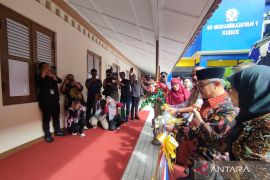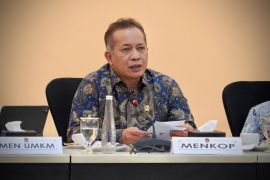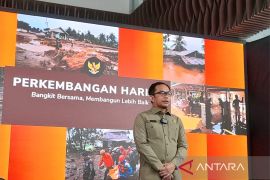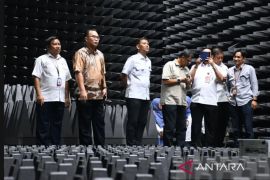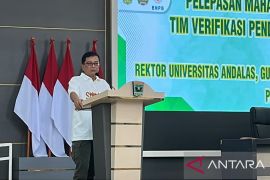Located in Ulu 13, Al-Munawar kampong is now being developed into a religious tourism site, particularly to be promoted as part of the TSE tour, and also during the 18th Asian Games to be held in the city in 2018.Palembang, S Sumatra (ANTARA News) - Palembang is expected to emerge as one of the favorite cities catering to tourists and scientists wanting to watch the total solar eclipse scheduled to occur on March 9 this year.
The city administration has been gearing up to facilitate the visitors in witnessing the very rare and spectacular phenomenon as well to explore various interesting tourism sites in the capital of South Sumatra Province.
Palembang is a multi-ethnic city where Malays, Javanese and those of Chinese and Arab descent have been living harmoniously and peacefully for hundreds of years.
It has the potential to develop religious, culinary, shopping and historical tourism attractions.
The citys icon, Ampera Bridge, will remain closed for public vehicles on the day of the eclipse, facilitating the pedestrians to observe the eclipse from the vantage point on the bridge freely and clearly.
Not far from the bridge, there is the little-known Al-Munawar kampong, an old Arab quarter which has a vibrant Islamic environment and a distinctive culture.
Unlike the citys China Town, Al Munawar is not famous although the area has been designated as a cultural reserve, based on a local law number 5 of the year 1992.
Located in Ulu 13, Al-Munawar kampong is now being developed into a religious tourism site, particularly to be promoted as part of the TSE tour, and also during the 18th Asian Games to be held in the city in 2018.
The development of faith tourism was aimed at harnessing Musi Rivers tourism potential, Irene Camalyn Sinaga of the South Sumatra tourism and culture office, stated in Palembang recently.
Musi Rivers tourism should be supported by other tourist attractions, she remarked.
Accommodating some 75 families comprising 250 inhabitants, most of the kampongs houses are over a century old, and some are up to 350 years old.
The Arab kampong was built some 400 years ago by Syed Abdurrahman bin Muhammad Al-Munawar, a Yemeni migrant who had married Princess Masayu Bariyah, a Sultans daughter.
The kampong has eight Palembang traditional wooden houses, and European style houses located along the Muri River.
One of the traditional wooden houses is 373 years old, measuring 30x16 meters and inhabited by nine to 10 families.
The fifth generation of Syed Abdurrahman bin Mahammad Al-Munawar currently lives in the kampong.
The South Sumatra authorities have informed the kampongs inhabitants of the plan to develop the area into a religious tourist site, Ahmad Alkaff, a local prominent figure, said recently.
Its roads will be renovated, houses will be painted, and public toilets will be set up in the kampong, which is located near the bank of the Musi River.
The local authorities are renovating a pier on the Musi river, located next to Al-Munawar Mosque, and cleaned up the area recently, Alkaff stated.
"A small caf' is planned to be opened there (near the pier), so that tourists can enjoy their coffee and savor Arabic food such as kebuli (like Indian Briyani), ghee rice, and lamb curry," Alkaff said.
He said the kampongs inhabitants have lauded the governments plan to turn the Arab quarter into a religious tourist site as they are used to receiving foreign tourists, among others from the Middle East, Europe and Southeast Asia.
Foreign tourists are welcome as long as they wear decent clothes, and avoid miniskirts or hot pants, he added.
Initially, however, the local residents had objected to the plan as they were worried that the presence of tourists would have an adverse impact on them.
However, they later agreed after the authorities convinced them that they would control the appearance of tourists attired in a fashion that is not in accordance with local customs, according to Alkaf.
The authorities would set up a room at the Kampongs gate, where tourists would be asked to cover their heads and any other parts of their bodies as appropriate with headscarves and long skirts made available there, before traveling around the kampong.
Head of South Sumatras health office Lesty Nuraini said she would support the plan by ensuring cleanliness of the kampong and by educating the local inhabitants regarding the need to lead a healthy lifestyle.
Head of the South Sumatra historical and ancient heritage office Candra Amprayadi said the renovation of the Arab town is expected to be completed this year, and it will be ready to receive tourists beginning 2017.
"In fact, it is planned that some houses will be developed into homestays that will accommodate tourists interested in staying overnight here, and researchers," he added.
Some three million tourists visited South Sumatra last year, and the province has set a target to attract five million tourists this year.
Hundreds of tourists from 12 countries have made reservations in star-rated hotels in Palembang to watch the TSE.
The tourists wanted to observe the rare and spectacular natural phenomenon from Ampera Bridge, Chairman of the south Sumatra Association of Hotel and Restaurant Owners (PHRI) Herlan Aspiudin said on Feb. 24.
The tourists are from countries such as Singapore, Malaysia, France, and Britain, in addition to Germany, Belgium, the Netherlands, and the United States, among others.
Besides South Sumatra, the eclipse will be visible for around two to three minutes in 12 provinces: Bengkulu, West Sumatra, Jambi, Bangka Belitung, West Kalimantan, Central Kalimantan, South Kalimantan, East Kalimantan, West Sulawesi, Central Sulawesi and North Maluku.
The last total solar eclipse occurred in Indonesia in 1988, but the TSE that will happen on March 9, 2016, is predicted to happen next after 100 years. (*)
Reporter: Fardah
Editor: Heru Purwanto
Copyright © ANTARA 2016


